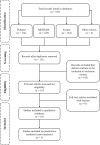The Effect of Fixture Congestion on Performance During Professional Male Soccer Match-Play: A Systematic Critical Review with Meta-Analysis
- PMID: 33068272
- PMCID: PMC7846542
- DOI: 10.1007/s40279-020-01359-9
The Effect of Fixture Congestion on Performance During Professional Male Soccer Match-Play: A Systematic Critical Review with Meta-Analysis
Abstract
Background: Fixture congestion (defined as a minimum of two successive bouts of match-play, with an inter-match recovery period of < 96 h) is a frequent and contemporary issue in professional soccer due to increased commercialisation of the sport and a rise in the number of domestic and international cup competitions. To date, there is no published systematic review or meta-analysis on the impact of fixture congestion on performance during soccer match play.
Objective: We sought to conduct a systematic review and meta-analysis of the literature related to the effects of fixture congestion on physical, technical, and tactical performance in professional soccer match-play.
Methods: Adhering to PRISMA guidelines and following pre-registration with the Open Science Framework ( https://osf.io/fqbuj ), a comprehensive and systematic search of three research databases was conducted to identify articles related to soccer fixture congestion. For inclusion in the systematic review and meta-analysis, studies had to include male professional soccer players, a congestion period that contained two matches ≤ 96 h, and have outcome measures related to physical, technical or tactical performance. Exclusion criteria comprised non-male and/or youth players, data that only assessed impact of congestion on injury, used simulated protocols, or were grey literature, such as theses or dissertations.
Results: Out of sixteen articles included in the systematic review, only five were eligible for the meta-analysis, and the only variable that was measured consistently across studies was total distance covered. Fixture congestion had no impact on total distance covered [p = 0.134; pooled standardized mean difference; Hedge's G = 0.12 (- 0.04, 0.28)]. Between-study variance, heterogeneity, and inconsistency across studies were moderate [Cochrane's Q = 6.7, p = 0.150, I2 = 40.7% (CI 0.00, 93.34)]. Data from articles included in the systematic review suggest fixture congestion has equivocal effects on physical performance, with variation between studies and low quality of research design in some instances. Tactical performance may be negatively impacted by fixture congestion; however, only one article was identified that measured this element. Technical performance is unchanged during fixture congestion; however, again, research design and the sensitivity and relevance of methods and variables require improvement.
Conclusion: Total distance covered is not impacted by fixture congestion. However, some studies observed a negative effect of fixture congestion on variables such as low- and moderate-intensity distance covered, perhaps suggesting that players employ pacing strategies to maintain high-intensity actions. There is a lack of data on changes in tactical performance during fixture congestion. With ever increasing numbers of competitive matches scheduled, more research needs to be conducted using consistent measures of performance (e.g., movement thresholds) with an integration of physical, technical and tactical aspects.
Conflict of interest statement
Ross Julian, Richard M Page and Liam D Harper declare no conflicts of interest.
Figures



References
-
- Carling C, Dupont G. Are declines in physical performance associated with a reduction in skill-related performance during professional soccer match-play? J Sports Sci. 2011;29:63–71. - PubMed
-
- Carling C, Le Gall F, Dupont G. Are physical performance and injury risk in a professional soccer team in match-play affected over a prolonged period of fixture congestion? Int J Sports Med. 2012;33:36–42. - PubMed
-
- Dellal A, Lago-Peñas C, Rey E, Chamari K, Orhant E. The effects of a congested fixture period on physical performance, technical activity and injury rate during matches in a professional soccer team. Br J Sports Med. 2015;49:390–394. - PubMed
-
- Gouttebarge V, Brink MS, Kerkhoffs GMMJ. The perceptions of elite professional footballers on the International Match Calendar: a cross-sectional study. Sci Med Footb. 2019;3:339–342.
-
- Nedelec M, McCall A, Carling C, Legall F, Berthoin S, Dupont G. Part I—post-match fatigue and time course of recovery. Sports Med. 2012;42(12):997–1015. - PubMed
Publication types
MeSH terms
LinkOut - more resources
Full Text Sources

